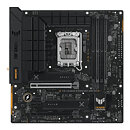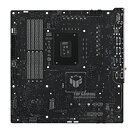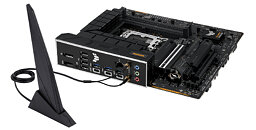TheLostSwede
News Editor
- Joined
- Nov 11, 2004
- Messages
- 18,491 (2.47/day)
- Location
- Sweden
| System Name | Overlord Mk MLI |
|---|---|
| Processor | AMD Ryzen 7 7800X3D |
| Motherboard | Gigabyte X670E Aorus Master |
| Cooling | Noctua NH-D15 SE with offsets |
| Memory | 32GB Team T-Create Expert DDR5 6000 MHz @ CL30-34-34-68 |
| Video Card(s) | Gainward GeForce RTX 4080 Phantom GS |
| Storage | 1TB Solidigm P44 Pro, 2 TB Corsair MP600 Pro, 2TB Kingston KC3000 |
| Display(s) | Acer XV272K LVbmiipruzx 4K@160Hz |
| Case | Fractal Design Torrent Compact |
| Audio Device(s) | Corsair Virtuoso SE |
| Power Supply | be quiet! Pure Power 12 M 850 W |
| Mouse | Logitech G502 Lightspeed |
| Keyboard | Corsair K70 Max |
| Software | Windows 10 Pro |
| Benchmark Scores | https://valid.x86.fr/yfsd9w |
Back in October of last year, pictures from an ASUS event in China appeared online, showing off a pair of mATX motherboards that had most of its peripheral and power connectors on the reverse side of the motherboard. Now it appears that ASUS has decided to launch such a product, in the shape of the unforgettably named TUF Gaming B760M-BTF WiFi D4. The BTF part in the model name stands Back To (the) Future, although ASUS is most likely not allowed to use that term due to copyright restrictions, so it had to make do with BTF. Regardless of naming, the interesting part here is that all of the power connectors, the four SATA ports, the USB-C and USB 3.0 headers, as well as multiple other headers and one of three M.2 slots, are on the reverse side of the motherboard. This is all done to allow for cleaner cable management.
Other noteworthy features on the board include a single PCIe 5.0 x16 slot, one PCIe 4.0 x4 and one x1 slot, three USB-C ports, of which one is capable of 20 Gbps speeds and 2.5 Gbps Ethernet. As this is a mid-range board, we presume ASUS wants to test the waters so to speak, to make sure there's a market for such a product. However, one major hurdle is the small fact that there aren't any suitable chassis in the market and the product page even mentions that "This motherboard is compatible with specific case models", without going into any details. Presumably, ASUS will offer a suitable chassis, or have some partner(s) lined up that will provide a suitable chassis. Gigabyte announced something similar in May last year, but decided to team up with system integrators, something ASUS might be planning on as well.



View at TechPowerUp Main Site | Source
Other noteworthy features on the board include a single PCIe 5.0 x16 slot, one PCIe 4.0 x4 and one x1 slot, three USB-C ports, of which one is capable of 20 Gbps speeds and 2.5 Gbps Ethernet. As this is a mid-range board, we presume ASUS wants to test the waters so to speak, to make sure there's a market for such a product. However, one major hurdle is the small fact that there aren't any suitable chassis in the market and the product page even mentions that "This motherboard is compatible with specific case models", without going into any details. Presumably, ASUS will offer a suitable chassis, or have some partner(s) lined up that will provide a suitable chassis. Gigabyte announced something similar in May last year, but decided to team up with system integrators, something ASUS might be planning on as well.



View at TechPowerUp Main Site | Source



 On the downside, I can see lots of RMA requests from people who didn't check for case compatibility and/or were unaware of the connectors' odd location.
On the downside, I can see lots of RMA requests from people who didn't check for case compatibility and/or were unaware of the connectors' odd location.



